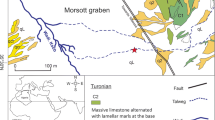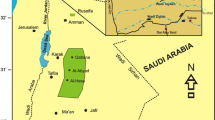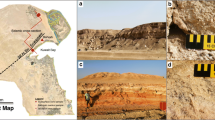Abstract
Several pieces of fossil bones of scute (scutum), shells, teeth, ribs, and vertebra belonging to turtle, crocodile, hippo, and other unidentified mammals were collected from the Oligocene Qatrani Formation, Fayoum, Egypt. Natural radioactivity was measured to all samples of the country rocks (mainly sandstone, calcareous muddy sandstone and dolostone), in addition to the bone samples. Petrographic examination, XRD, SEM, and complete chemical analyses were done with an emphasis on the more radioactive samples that comprise both fossil bone samples and dolostone. The main mineral composition of these bones is carbonate fluorapatite (francolite), while dolostone consists of microcrystalline dolomite, which is cemented by gypsum and/or silica. The complete chemical analysis indicates that Ca and P are the main components of fossil bone. The high content of the redox-sensitive elements such as Cu, Zn, Se, Mo, Cd, Sn, and Pb is a diagnostic feature of the fossil bones. The total rare earth elements (REE) in fossil bones ranges between 635 and 4984 ppm but decreases to 90 ppm in the dolostone bed. The high content of the REE in fossil bones seems to be a result of interaction with fluids that were heated by the thermal gradients prevailed during the Oligocene volcanic eruptions. The available data indicate that the fossil bones are more enriched in their uranium contents (from 42 to 457 ppm), while the contents in the country rocks include the dolostone range from 1 to 31 ppm. The fraction of heavy minerals of the studied sandstone is generally enriched in magnetite, ilmenite, and leucoxene as opaques especially magnetite and ilmenite (> 50%) and contains a wide variety of non-opaques such as zircon, rutile, garnet, and kyanite among others. These non-opaque minerals have variable but insignificant impacts on the REE pattern and the natural radioactivity of the bone-bearing sediments.










Similar content being viewed by others
References
Abu Zeid S, Abdel Monem AA (1957) The discovery of uranium-bearing Quartzitic veins at Gebel Qatrani area, Geology and Raw Material Dept., AEE, Cairo, Internal Report
Allen JRL (1965) A review of the origin and characteristics of recent alluvial sediments. Sedimentology 5:89–191
Ayling BF, Eggins S, McCulloch MT, Chappell J, Grün R, Mortimer G (2017) Uranium uptake history, open-system behavior and uranium-series ages of fossil Tridacna gigas from Huon Peninsula, Papua New Guinea. Geochim Cosmochim Acta 213:475–501
Bourdon B, Henderson GM, Lundstrom CC, Turner SP (2003) Uranium-series geochemistry. Rev Mineral Geochem p. 52:656
Bowen BE, Vondra CF (1974) Paleoenvironmental interpretation of the Gebel Qatrani Formation, Fayoum Depression, Egypt. Ann Geol Surv Egypt 4:115–138
Charalambous S, Papastefanou C (1977) On the radioactivity of fossil bones. Nucl Inst Methods 142(3):581–588
Cumberland SA, Etschmann B, Brugger J, Douglas G, Evans K, Fisher L, Kappen P, Moreau JW (2018) Characterization of uranium redox state in organic-rich Eocene sediments. Chemosphere 194:602–613
Decrée S, Herwartz D, Mercadier J, Miján I, Buffrénil V, Leduc T, Lambert O (2018) The post-mortem history of a bone revealed by its trace element signature: the case of a fossil whale rostrum. Chem Geol 477:137–150
El-Eraky F (1988) Petrographical and mineralogical studies of the bone-bearing sediments of El-Fayoum, Egypt. M.Sc. Thesis, Faculty of Science, Al Azhar University
El-Kammar AM (1985) Geochemistry and rare earth pattern of terrestrial and marine apatites from Egypt. J Jpn Assoc Mineral Petrol Econ Geol 1:21–33
El-Kammar AM, Hancock GV, Allen RO (1989) Human bones as archaeological samples: changes due to contamination and diagenesis. In: Allen RO (ed) Chapter 18Archaeological chemistry IV, advances in chemistry series, vol 220. American Chemical Society, Washington D.C, pp 337–352
El-Kammar MM, El-Kammar AM, El-Gamal MA (2000) Geochemistry of terrestrial tertiary bones from Fayium, Egypt. 5th International Conference on the Geology of the Arab World, Cairo University, 213–238
El-Shazly EM et al. (1974) Origin of uranium in Oligocene Qatrani sediments, Western Desert, ARE. Proceeding of IAEA, 467–477
Fortin SD, Leppard GG, Tessier A (1993) Characteristics of lacustrine diagenetic iron hydroxides. Geochim Cosmochim Acta 57(18):4391–4404
Hansink JD (1976) Equilibrium analysis of sandstone roll-front uranium deposits. Proceeding of International Symposium on Exploration of uranium ore deposits. IAEA-SM-208/13, IAEA, Vienna, 683–693
Khawasik S (1967) Proving of radioactive occurrences, Qatrani area, Western Desert. Internal report. Geology and Nuclear Raw Materials Dept, U.A.R.
Kim T, Lee Y, Lee Y-N (2018) Fluorapatite diagenetic differences between Cretaceous skeletal fossils of Mongolia and Korea. Palaeogeogr Palaeoclimatol Palaeoecol 490:579–589
Mathur (1988) Regional palaeontological laboratory, geological survey of India, B-201, Rajendra Marg, Bapu Nagar, Jaipur 302–315
McConnell D (1973) Apatite: Its crystal chemistry, mineralogy, utilization, geologic and biologic occurrences. Springer, New York, p. 111
McLennan SM (1989) Rare earth elements in sedimentary rocks: influence of provenance and sedimentary process. Rev Mineral 21:169–200
Morsy MA (1978) Lithological, stratigraphical and structural controls of uranium mineralization of Qatrani area, Western Desert. M.Sc. Thesis, Faculty of Science, Cairo University, Cairo
Mostafa ME (1972) Geological studies for uranium occurrences in Qatrani area, Western Desert, A.R.E. M.Sc. Thesis, Faculty of Science, Cairo University
Nathan Y, Bremner J, Lowenthal R, Monterio P (1993) Role of bacteria in phosphorite genesis. Geomicrobiol J 11:69–76
OECD/NEA-IAEA (2010) The security of energy supply and the contribution of nuclear energy. NEA No. 6358, Nuclear Energy Agency Organisation for Economic Co-operation and Development
Prevot L, El Faleh M, Lucas J (1989) Details on synthetic apatites formed through bacterial mediation, Mineralogy and chemistry of the products. Sci Geol Bull Strasbourg 42:237–254
Rao VP, Rao CM, Thamban M, Natarajan R, Rao BR (1995) Origin and significance of high-grade phosphorites in a sediment core from the continental-slope off Goa, India. Curr Sci 69(12):1017–1022
Raslan MF, El-Feky MG (2012) Radioactivity and mineralogy of the altered granites of the Wadi Ghadir shear zone, south Eastern Desert, Egypt. Chin J Geochem 31(1):30–40
Raslan MF, HarounYS (2010) Geology and mineralogy of the radioactive Quaternary sediments of the north Fayium depression, Western Desert, Egypt. Geol Croatica 333–343
Rudnick RL, Gao S (2004) Composition of the continental crust. In: Holland HD, Turekian KK (eds) Treatise on geochemistry, vol 3. Elsevier, Amsterdam, pp 1–64
Said R (1962) Geology of Egypt. Elsevier, Amsterdam, p. 377
Salama W, El-Kammar A, Saunders M, Morsy R, Kong C (2015) Microbial pathways and palaeoenvironmental conditions involved in the formation of phosphorite grains, Safaga District, Egypt. Sediment Geol 325:41–58
Simons EL (1968) Early Cenozoic mammalian faunas of Fayum Province, Egypt. Part I: African Oligocene Mammals. Bull Peabody Mus Nat Hist, Yale Univ., New Haven, 28:1–22
Swedan AH (1992) Stratigraphy of the Eocene sediments in the Fayoum area. Annals Geol. Surv. Egypt 18: 157–166.
Taylor SR, McLennan SM (1985) The continental crust: its composition and evolution. Blackwell Scientific Publication, Carlton, p. 312.
Udas GR, Mahadevan TM (1974) Controls and genesis of uranium mineralization in some geological environments in India. Proc. Symp. on the Formation of uranium ore deposits Organized by the IAEA, Athens, Greece, 183/39:425
Wanas HA, Soliman HE (2014) Calcretes and palustrine carbonates in the Oligo-Miocene clastic-carbonate unit of the Farafra Oasis, Western Desert, Egypt: Their origin and paleoenvironmental significance. J Afr Earth Sci 95:145–154
Williams CT, Henderson P, Marlow CA, Molleson TI (1997) The environment of deposition indicated by the distribution of rare earth elements in fossil bones from Olduvai Gorge, Tanzania. Appl Geochem 12(4):537–547
Zougrou ΙM, Stoulos S, Kantiranis N, Papadopoulou L, Ioakeimidis I, Katsikini M, Paloura E, Tsoukala E (2018) Natural radioactivity studies in a paleontology site and paleoclimate interpretation of the last 8 Mya. J Environ Radioact 193–194:1–14
Acknowledgments
The critical remarks and correction made by the editors and the reviewer are highly appreciated. Their revision improved the quality of this work.
Author information
Authors and Affiliations
Corresponding authors
Additional information
Responsible Editor: Beatriz Badenas
Rights and permissions
About this article
Cite this article
El-Kammar, A., El-Sankary, M., El-Azab, A. et al. Composition and radioactivity of Oligocene fossil bones and their country rocks in Gabal Qatrani, Fayoum, Egypt. Arab J Geosci 13, 570 (2020). https://doi.org/10.1007/s12517-020-05313-x
Received:
Accepted:
Published:
DOI: https://doi.org/10.1007/s12517-020-05313-x




